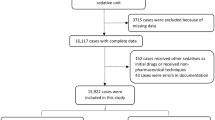Abstract
Background
Paradoxical hyperactivity (PH) is a known complication of sedation in children, especially with barbiturates such as pentobarbital. The accompanying inconsolable irritability and agitation, similar to behaviors reported in children with attention deficit hyperactivity disorder (ADHD), is uncomfortable for the child and anxiety-provoking for parents and health-care workers. Our objective was to describe our experience with oral (PO) and intravenous (IV) caffeine as a treatment for sedation-induced PH.
Materials and methods
From January 2000 to April 2003, 19,894 children were sedated in our institution for radiology procedures. Of these, 360 children were diagnosed with PH. A total of 229 children exhibiting symptoms of PH after sedative administration were treated with PO caffeine (n=88; 43 boys, 45 girls; mean age 4.5 years, mean weight 18.7 kg) or IV caffeine (n=131; 73 boys, 58 girls; mean age 4.8 years, mean weight 20.1 kg) or both (n=10; 8 boys, 2 girls; mean age 5.0 years, mean weight 19.9 kg). A positive effect was defined as a decrease in agitation, crying, or hyperactivity within 40 min of caffeine administration. A control group (n=45) was obtained from those 141 children who experienced post-sedation PH but were not treated with caffeine, and matched for age and sex with samples of children treated with IV caffeine (n=45) and PO caffeine (n=45).
Results
Children treated intravenously received the equivalent of 20 mg/kg caffeine citrate (to a maximum of 200 mg). Of those treated with IV caffeine, 82/131 (63%) showed a positive effect, and returned to baseline behavioral status after an average of 33 min (SD=23 min). The untreated control group required a significantly longer time to recover (P<0.01) than those treated with IV caffeine. Children treated orally received approximately 1.0–2.5 mg/kg caffeine in Mountain Dew (Pepsi-Cola Company), and 36/88 (41%) showed a positive effect and returned to baseline behavioral status after an average of 42 min (SD=27 min). Of the 10 children treated with both PO and IV caffeine, 6 showed a positive effect. There was no significant difference in recovery time between the untreated control group and either the matched orally treated group or the group treated with both IV and PO caffeine. No complications occurred after caffeine administration.
Conclusion
IV caffeine appears to be an effective treatment for PH in children with sedation-induced PH. Further controlled prospective study is needed to determine the optimum dose and route of administration and to compare efficacy with other potential drug classes.

Similar content being viewed by others
References
Strain JD, Campbell JB, Harvey LA, et al (1988) IV Nembutal: safe sedation for children undergoing CT. AJR 151:975–979
Slovis TL, Parks C, Reneau D, et al (1993) Pediatric sedation: short-term effects. Pediatr Radiol 23:345–348
Bunt C, Towbin R (2000) Treatment of pentobarbital sodium (Nembutal) hyperactivity: a new approach. Pediatr Radiol 30:204
Karian VE, Burrows PE, Zurakowski D, et al (1999) Sedation for pediatric radiological procedures: analysis of potential causes of sedation failure and paradoxical reactions. Pediatr Radiol 29:869–873
Leung AK, Lemay JF (2003) Attention deficit hyperactivity disorder: an update. Adv Ther 20:305–318
Adesman AR (2001) The diagnosis and management of attention-deficit/hyperactivity disorder in pediatric patients. Prim Care Companion J Clin Psychiatry 3:66–77
Schechter MD, Timmons GD (1985) Objectively measured hyperactivity—II. Caffeine and amphetamine effects. J Clin Pharmacol 25:276–280
Castellanos FX, Rapoport JL (2002) Effects of caffeine on development and behavior in infancy and childhood: a review of the published literature. Food Chem Toxicol 40:1235–1242
Author information
Authors and Affiliations
Corresponding author
Rights and permissions
About this article
Cite this article
Rubin, J.T., Towbin, R.B., Bartko, M. et al. Oral and intravenous caffeine for treatment of children with post-sedation paradoxical hyperactivity. Pediatr Radiol 34, 980–984 (2004). https://doi.org/10.1007/s00247-004-1303-8
Received:
Revised:
Accepted:
Published:
Issue Date:
DOI: https://doi.org/10.1007/s00247-004-1303-8




